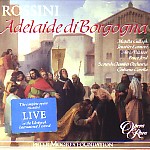Adelaide di Borgogna premiered in Rome in December, 1817, within months of La Gazza Ladra (in Milan) and Armida (in Naples); Rossini’s next opera was Mosè in Egitto, five months later (for Naples). Adelaide disappeared after its initial two-week run until a production at the Martina Franca Festival in 1984; then it vanished again until this undertaking at the 2005 Edinburgh Festival. The Martina Franca performance was available on Fonit Cetra for a while and is a pretty good show; however, this new Opera Rara set is the one to own.
The opera comes close to deserving its relative obscurity. The plot concerns Adelaide (soprano), who was Holy Roman Empress, widow of the Italian King Lothaire. She is imprisoned by Berengario (bass), who wants to marry her to his son, Adalberto (tenor). Adelaide turns to the German Emperor Ottone (mezzo-soprano), who helps her defeat Berengario and then marries her, becoming Holy Roman Emperor.
Simple and direct, there are some Rossinian delights in the opera: Adelaide’s scene in Act 1, her pyrotechnical duet with Ottone, an exciting first finale, a good aria for Adalberto, and Ottone’s rondo finale. But the recitatives and arias for minor characters are dull–so dull that there are doubts that Rossini composed them at all. But this shouldn’t stop Rossini fans from enjoying this recording: the performance is excellent and full of life, and it contains much thrilling singing.
Majella Cullagh’s bright sound is just right for Adelaide; it never lapses into a soubrettish sweetness and has real fire. Pyrotechnically Cullagh is all you’d want, and she also colors the text as if she means it. Her final aria is a reworking of Almaviva’s “Cessa di piu resistere” from Barbiere–an interesting study. Jennifer Larmore’s discography continues to impress, and her Ottone is rock solid, heroic and unique in its smoky middle voice and brilliant top, with plenty of room for coloratura fireworks. The two women are spectacular in their duets.
Texan tenor Bruce Ford, so spectacular for a couple of decades in this difficult repertoire, is finally beginning to show signs of aging. His tone has dried considerably, his vibrato is somewhat loose, and his coloratura is not nearly as spot-on as previously. It is a sign of his artistry, however, that he’s a persuasive, expressive Adalberto nonetheless. Similarly, the Berengario of bass Mirco Palazzi lacks menace and stature; his voice needs more juice for the part. The smaller roles are well taken, but as mentioned above, their music is not particularly interesting. Conductor Giuliano Carella keeps things lively while making certain that his virtuoso singers have space, the sound is excellent, even with some wild applause, and as usual, Opera Rara’s booklet notes are informative and interesting. A delight for bel cantoists.
































